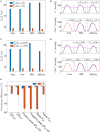Effects of Mechanical Dyssynchrony on Coronary Flow: Insights From a Computational Model of Coupled Coronary Perfusion With Systemic Circulation
- PMID: 32922304
- PMCID: PMC7457036
- DOI: 10.3389/fphys.2020.00915
Effects of Mechanical Dyssynchrony on Coronary Flow: Insights From a Computational Model of Coupled Coronary Perfusion With Systemic Circulation
Abstract
Mechanical dyssynchrony affects left ventricular (LV) mechanics and coronary perfusion. Due to the confounding effects of their bi-directional interactions, the mechanisms behind these changes are difficult to isolate from experimental and clinical studies alone. Here, we develop and calibrate a closed-loop computational model that couples the systemic circulation, LV mechanics, and coronary perfusion. The model is applied to simulate the impact of mechanical dyssynchrony on coronary flow in the left anterior descending artery (LAD) and left circumflex artery (LCX) territories caused by regional alterations in perfusion pressure and intramyocardial pressure (IMP). We also investigate the effects of regional coronary flow alterations on regional LV contractility in mechanical dyssynchrony based on prescribed contractility-flow relationships without considering autoregulation. The model predicts that LCX and LAD flows are reduced by 7.2%, and increased by 17.1%, respectively, in mechanical dyssynchrony with a systolic dyssynchrony index of 10% when the LAD's IMP is synchronous with the arterial pressure. The LAD flow is reduced by 11.6% only when its IMP is delayed with respect to the arterial pressure by 0.07 s. When contractility is sensitive to coronary flow, mechanical dyssynchrony can affect global LV mechanics, IMPs and contractility that in turn, further affect the coronary flow in a feedback loop that results in a substantial reduction of dP LV /dt, indicative of ischemia. Taken together, these findings imply that regional IMPs play a significant role in affecting regional coronary flows in mechanical dyssynchrony and the changes in regional coronary flow may produce ischemia when contractility is sensitive to the changes in coronary flow.
Keywords: bi-directional interactions; coronary perfusion; ischemia; mechanical dyssynchrony; systemic circulation.
Copyright © 2020 Fan, Namani, Choy, Kassab and Lee.
Figures







Similar articles
-
Role of coronary flow regulation and cardiac-coronary coupling in mechanical dyssynchrony associated with right ventricular pacing.Am J Physiol Heart Circ Physiol. 2021 Mar 1;320(3):H1037-H1054. doi: 10.1152/ajpheart.00549.2020. Epub 2020 Dec 24. Am J Physiol Heart Circ Physiol. 2021. PMID: 33356963 Free PMC article.
-
Regional ischemic ventricular dysfunction in myocardium supplied by a narrowed coronary artery with increasing halothane concentration in the dog.Anesthesiology. 1981 Oct;55(4):349-59. doi: 10.1097/00000542-198110000-00004. Anesthesiology. 1981. PMID: 7294369
-
Left anterior descending coronary artery flow impaired by right ventricular apical pacing: the role of systolic dyssynchrony.Int J Cardiol. 2014 Sep;176(1):80-5. doi: 10.1016/j.ijcard.2014.06.037. Epub 2014 Jul 2. Int J Cardiol. 2014. PMID: 25042658
-
Diltiazem and regional left ventricular function during graded coronary constriction and propofol anesthesia in the dog.J Cardiothorac Vasc Anesth. 1993 Dec;7(6):705-10. doi: 10.1016/1053-0770(93)90056-q. J Cardiothorac Vasc Anesth. 1993. PMID: 8305661
-
Myocardial mechanics and coronary flow dynamics.Adv Exp Med Biol. 1993;346:125-36. doi: 10.1007/978-1-4615-2946-0_12. Adv Exp Med Biol. 1993. PMID: 8184751 Review.
Cited by
-
Mechanism of exercise intolerance in heart diseases predicted by a computer model of myocardial demand-supply feedback system.Comput Methods Programs Biomed. 2022 Dec;227:107188. doi: 10.1016/j.cmpb.2022.107188. Epub 2022 Oct 21. Comput Methods Programs Biomed. 2022. PMID: 36334525 Free PMC article.
-
Comparison of Left Ventricular Function Derived from Subject-Specific Inverse Finite Element Modeling Based on 3D ECHO and Magnetic Resonance Images.Bioengineering (Basel). 2024 Jul 20;11(7):735. doi: 10.3390/bioengineering11070735. Bioengineering (Basel). 2024. PMID: 39061817 Free PMC article.
-
A Closed-Loop Modeling Framework for Cardiac-to-Coronary Coupling.Front Physiol. 2022 Feb 28;13:830925. doi: 10.3389/fphys.2022.830925. eCollection 2022. Front Physiol. 2022. PMID: 35295571 Free PMC article.
-
Review of cardiac-coronary interaction and insights from mathematical modeling.WIREs Mech Dis. 2024 May-Jun;16(3):e1642. doi: 10.1002/wsbm.1642. Epub 2024 Feb 5. WIREs Mech Dis. 2024. PMID: 38316634 Free PMC article. Review.
-
The Comparison of Different Constitutive Laws and Fiber Architectures for the Aortic Valve on Fluid-Structure Interaction Simulation.Front Physiol. 2021 Jun 24;12:682893. doi: 10.3389/fphys.2021.682893. eCollection 2021. Front Physiol. 2021. PMID: 34248670 Free PMC article.
References
LinkOut - more resources
Full Text Sources

